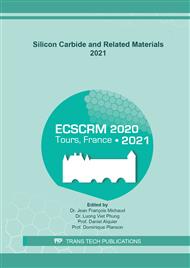[1]
Hirokuni Tokuda, Maiko Hatano, Norimasa Yafune, Shin Hashimoto, Katsushi Akita, Yoshiyuki Yamamoto, and Masaaki Kuzuhara, High Al Composition AlGaN-Channel High-Electron-Mobility Transistor on AlN Substrate, Appl. Phys. Express, 3 (2010) 121003.
DOI: 10.1143/apex.3.121003
Google Scholar
[2]
G. R. Yazdi, R. Vasiliauskas, M. Syväjärvi, and R. Yakimova, Fabrication of free-standing AlN crystals by controlled microrod growth, J. Cryst. Growth, Vol. 310, issue 5 (2008) 935-939.
DOI: 10.1016/j.jcrysgro.2007.11.124
Google Scholar
[3]
Tsvetanka S. Zheleva, Scott A. Smith, Darren B. Thomson, Kevin J. Linthicum, Pradeep Rajagopal, and Robert F. Davis, Pendeo-epitaxy: A new approach for lateral growth of gallium nitride films, J. Electron. Mater., 28 (1999) L5-L8.
DOI: 10.1007/s11664-999-0239-z
Google Scholar
[4]
R. R. Sumathi, R. U. Barz, P. Gille, and T. Straubinger, Influence of interface formation on the structural quality of AlN single crystals grown by sublimation method, Physica Status Solidi C, 8.7– 8 (2011) 2107–2109.
DOI: 10.1002/pssc.201000941
Google Scholar
[5]
Philip G. Neudeck, J. Anthony Powell, Glenn M. Beheim, Emye L. Benavage, and Phillip B. Abel, Enlargement of step-free SiC surfaces by homoepitaxial web growth of thin SiC cantilevers, J. Appl. Phys., 92 (2002) 2391.
DOI: 10.1063/1.1497456
Google Scholar
[6]
Christian Schumacher, Steve Marschner, Markus Gross, and Bernhard Thomaszewski, Mechanical characterization of structured sheet material, ACM Trans. Graph., Vol. 37, No. 4, 148 (2018) 1–15.
DOI: 10.1145/3197517.3201278
Google Scholar
[7]
Shoji Ushio, Tatsuya Karaki, Kenta Hagiwara, Noboru Ohtani, and Tadaaki Kaneko, Surface Phase Diagram of 4H-SiC {0001} Step-Terrace Structures during Si-Vapor Etching in a TaC Crucible, Mater. Sci. Forum, Vol. 717-720 (2012) 573-576.
DOI: 10.4028/www.scientific.net/msf.717-720.573
Google Scholar
[8]
Daichi Dojima, Koji Ashida, and Tadaaki Kaneko, In-situ growth mode control of AlN on SiC substrate by sublimation closed space technique, J. Cryst. Growth, Vol. 483, 1 (2018) 206-210.
DOI: 10.1016/j.jcrysgro.2017.11.032
Google Scholar
[9]
Martin Kuball, Raman spectroscopy of GaN, AlGaN and AlN for process and growth monitoring/control, Surf. Interface Anal., 31 (2001) 987–999.
DOI: 10.1002/sia.1134
Google Scholar
[10]
Yoshitaka Taniyasu, Makoto Kasu, and Toshiki Makimoto, Threading dislocations in heteroepitaxial AlN layer grown by MOVPEon SiC (0 0 0 1) substrate, J. Cryst. Growth, 298 (2007) 310–315.
DOI: 10.1016/j.jcrysgro.2006.10.032
Google Scholar


